
|
Longevity and loyalty are not two words normally associated with a spring training ballpark or a team that trains there, but the pairing of Joker Marchant Stadium and the Detroit Tigers have made Lakeland the current longest tenured exception while contributing to a marriage between town and team that is unmatched in the sport's exhibition history.
Excepting the World War II years of 1943-45, the Tigers have been wintering in Lakeland since 1934. Their 74 season run in one town is a spring training record for host city constancy and the next closest isn't even that close, as the Phillies’ tenure in Clearwater is a double-digit (10) number of seasons behind Detroit's stay in Lakeland. As such, Tiger fans have been making the trek to Lakeland for generations, beginning when the team set up camp at Henley Field, which still stands less than a mile and a half from where its replacement, Joker Marchant Stadium, opened in 1966. Three years later, the Pirates moved from Fort Myers to Bradenton’s McKechnie Field and that ballpark/team combo currently ranks second for a continuous use relationship to Lakeland’s partnership. During its first season of spring training use, two-thirds of Joker Marchant Stadium’s outfield was patrolled by Willie Horton and Al Kaline, two right-handers who would each go on to collect 138 hits during the 1966 regular season. Today, three decades after Horton retired and Kaline was inducted into the Hall of Fame, the two entrances that intersect outside of the stadium are named in honor of the Detroit duo.
Those who arrive at Tigertown, the name of the complex which the 17-acre stadium anchors, are greeted by a visually pleasing exterior that’s similar in style to nearby Champion Stadium, the Disney-based springtime playground of the Atlanta Braves. Each features arched entryways carved into a yellowish stucco façade, but where the two ballparks just 34 miles apart differ greatly in presentation is the real estate that surrounds their front perimeters. While Champion Stadium is packed tightly into a facility-laden 220-acre sports complex with concrete walkways connecting the adjoining venues, Joker Marchant Stadium is stately situated near a lush grass field that is pristinely maintained and contains palm trees. The two-laned Kaline Drive separates the grassy area from Joker Marchant’s home plate entrance, where a covered waiting area is in front of the ticket office that contains five windows in addition to its single will call window. Fans waiting under cover will notice they are standing on square-shaped bricks engraved with the words of the Tigers’ fans that purchased them. The personalized bricks surround an Old English "D" that was inlaid upon concrete in the center of the waiting area. The brick paver program is ongoing and the newer the inscribed brick the further away it is from Detroit's classic logo. While most fans buying tickets at the ticket office proceed to enter the ballpark via its adjacent Home Plate gate, those that arrive with tickets in tow use one of the two open-air gates that are placed closer to the parking lots. Each is named for their relative location, with signage simply stating “1st Base” and “3rd Base” attached to the wooden trellises above the appropriate gate. Joker Marchant Stadium’s roof is covered with the same reddish Spanish style faux tiles that top many a structure throughout Florida. Those tiles are an appropriate accent to the Mediterranean-style exterior façade, which includes a pair of towers alongside two of the stadium’s entrance gates. The towers are just to the left of the 1st Base and Home Plate gates. One contains a staircase, the other an elevator, and each resembles a bell tower. The home plate tower is the more visually arresting of the two. The approximately 10-foot tall arch at its base is filled with tiles upon which a mural of a real tiger is seen peering through a jungle scene. On the stucco above the mural are the words “Florida Home of the Detroit Tigers.” The first base tower contains no words or artistic décor. Shrubbery and palm trees planted a few feet from the stadium’s stucco walled and black iron fence perimeter completes an impressive first impression. The stadium’s varied interior vistas are accessed from a concourse that is behind the main grandstand, which provides cover for a wide variety of concessionaires and a picnic area. Near the picnic tables is a Little Caesars Pizza stand. Its primo placement behind home plate is a reminder of where Tigers owner Mike Ilitch made the millions he used to buy the team in 1992. Ilitch was a former minor league player in the Detroit system before founding the Little Caesars chain in 1959. Ironically, he bought the Tigers from Tom Monaghan, who founded Domino's Pizza in 1960. In addition to pizza, the regular ballpark staples are covered, while on opposite ends of the concourse creative sandwiches are served at a hexagonal hut and mouth watering barbeque is smoked and served from a portable cart. Beneath the left field grandstands, a permanent stand with a diner-like façade and neon sign touts “Good Eats,” and generally speaking, the offerings found in Lakeland are better than anywhere else in Florida, a qualified opinion I formed after visiting and dining at each Grapefruit League ballpark during spring training in 2009. In the rankings that ensued, Joker Marchant Stadium was rated #1 for the quality and quantity of its food. Among those enjoying Lakeland’s dining delicacies are the members of groups that book the party tent that’s near the 1st Base entry gate. Set up at the end, and uncovered portion, of the first base side concourse, a canopy covers numerous rows of tables and folding chairs that are used for pre-game meals. For groups that want to enjoy their meal and the game at the same time, the Tigers have them covered (quite literally) in the Officers' Club, a party deck-like area at the top of the third base grandstand. It’s wooden bar chairs and high top tables are under the stadium’s roof, as are the Club’s two rows of wood deck chairs that are railed off and elevated from the last row of seating in section 209. The name Officers' Club was derived from the Lakeland Flying Tigers, the minor league team that plays its games in the stadium when their parent club heads north. From 1967 to 2006, the team was simply called the Lakeland Tigers, but their moniker was amended in 2007 to pay homage to the Lodwick School of Aeronautics, which was the Southeast Air Corps Training Center for World War II pilots. Over 7,000 pilots trained for active duty at Lodwick, which stood on the same ground now occupied by Joker Marchant Stadium and the Tigertown complex. Visible proof of the site’s former use can be seen from the upper portions of the stadium’s third base and left field grandstands, where the rounded buildings that once served as airport hangars break up an otherwise tree dotted backdrop. The same seats that have views of the old hangars offer glimpses of one of the lakes that gave the city its name, as Lakeland's largest, the 2,181-acre Lake Parker, is just a half-mile from the stadium. Fans with the most privileged views of the Joker Marchant Stadium playing field sit in stadium seat filled balconies that front each of the six suites that flank either side of the press box. Two of them are on the first base side of home plate and four extend down the third base line, where the furthest suite down the line is just one section away from the Officers' Club. The six suites are named after Tiger legends Ty Cobb, Charlie Gehringer, Hank Greenberg, Willie Horton, Al Kaline and Hal Newhouser, although any signage designating them as such is not visible to the rank and file fan. Also obscured from view are the bullpens. The Tigers’ and visitors’ are parallel to each other, but placed behind the fence in right-center field, where they are almost 400 feet away from home plate. At that distance, binoculars are required to see what's going on in the bullpens, which are behind see-through fencing that benefits players more than inquisitive fans. The bullpens are between the batter’s eye and main scoreboard, which is capable of showing live video. Another scoreboard stands just to the left of the tarp covered batter's eye, but it's reminiscent of a Little League scoreboard, both in size and function. An equally diminutive display to the right of the batter's backdrop serves one function: to display the miles per hour of each thrown pitch. The two-story building halfway down the right field line serves a dual purpose. Its expansive first floor contains the clubhouses for both teams. The much smaller second floor holds the Tigers’ administrative offices and is perched atop the southwest corner of the ground-level clubhouse building, where it overlooks the field. The second story structure is enclosed with glass window paneling that enables the team's executives to watch the game in seclusion. Players and other uniformed personnel can often be seen milling outside of their respective clubhouses in the fence and screened-in walkway that runs alongside their “office.” Prior to 2003, the Tigers’ bullpen was between the two-story building and the grandstand, but a 10-month, $10 million renovation project moved it to its current location and filled in the vacated approximately 100 feet of space with five new sections of seating, all of which are angled ever so slightly towards the playing field.
In the odd looking add-on department is the trapezoid-shaped structure that was built at the same time the box seating sections were extended. The peculiar looking addendum contains two 200-level sections and looks like the main grandstand’s sidecar, as it's removed from the rest of the 200-level sections and is about half their height. Because of this separation, a limited amount of standing room is available in the gap that was created. A similar gap has long existed between the end of the third base and left field grandstands. Less utilized but more plentiful standing room is found within the main grandstand, which is filled with stadium-style green seats that have cup holders attached. Unbeknown to most, the two sections in front of the press box have what can be described as a passageway between their last row of seats and the facade of the media's workplace. It's a great place to stand for a fan that wants to take an elevated behind the plate snapshot and is also the best vantage point for anyone with a standing room only ticket. An additional place to stand can be found at the top of the first base grandstand, where an open plaza is also one of five uniquely selected areas on stadium grounds to have dedicated wheelchair spaces. Other handicapped accessible spots are found within the main grandstand, on its cross aisle, in a raised platform in the third base gap, and above the left field berm. The main grandstand at Joker Marchant Stadium is the original structure and became the oldest grandstand used at a current Grapefruit League ballpark following the Orioles' 2009 departure from Fort Lauderdale Stadium. Lakeland's grandstand surrounds the infield and its upper rows are covered by a roof that also casts shade upon many of the rows beyond its reach. The additional respite from the sun is due to the fact that it descends behind the grandstand over the course of the afternoon. While most of the stadium is roomy, the cross aisle between the main grandstand’s reserved and box seats are an exception. Ushers keep the narrow walkway clear at all times and it’s connected to the main concourse behind the grandstand via four equally narrow portals. Near the entrance to the portal that burrows through section 205 is a dry erase board that is filled out with the day’s starting line-ups. The actual entrance to that first base concourse portal has four weathered plaques upon its wall, one of which is the stadium’s original dedication plaque. The others honor the real life Joker Marchant, the 1968 world champion Tigers, and Al Kaline, whose plaque is the youngest of the four, having been dedicated on March 14, 1971. Among the more modern signage distributed throughout the concourse are signs that point the way toward the stadium’s evacuation route.
The upper rows of general admission bleachers are actually above the main grandstand's roof, which is an unusual sight that highlights their height. Fans sitting in the unmarked rows at the top of section 403 have a vantage point that is as far away from the field as possible and occupy the Grapefruit League's premiere nosebleed seats. Sitting in the bleachers is almost like being in a different ballpark. Wind that you didn't know existed elsewhere hits you at full force the higher you ascend. When you get to the top row you're rewarded with the temporary anxiety that one often experiences at considerable heights and it's from up there that you realize just how spacious the outfield is. At 420 feet to center and 340 feet down the lines, Joker Marchant has the most outfield territory of any ballpark in the state of Florida. If center field were just a little bit deeper, the outfield dimensions would actually form a square. The left field wall begins less than 50 feet from the end of the grandstand. In the space between the two, an alcove houses a roll away batting cage and behind it is a square-shaped parcel of grass that is marked with faded chalk lines and weathered concrete bases, a home plate and pitching rubber. The half-field in the left field corner is the stadium’s version of a kid’s play area, as Joker Marchant is absent of any playground equipment or inflatable distractions. Beyond the left field wall is the stadium’s comfortable berm. The manmade grass-covered hill was the most visible addition to the stadium in the wake of its 2003 renovation. Stretching from just inside of the left field foul pole to just shy of the center field batter’s eye, Lakeland’s version of a berm is sloped 45 feet and rises 16 feet in height from its base, which is about 5 feet from the backside of the outfield fence. The space between the berm and fence is filled with a sidewalk. Tiny shrubs line the back of the sidewalk and its retaining wall is a popular place to sit atop and watch the game.
Berm capacity is listed at 400 but it can hold up to 500 fans and the larger number is used to compute the stadium’s official capacity of 9,000. A practice field named after – you guessed it – Al Kaline is behind the berm. A set of bullpen mounds resides at the base of the berm’s backside and wandering youths sometimes find this area more enticing to play in than the aforementioned half-field in the left field corner. In addition to Al Kaline Field, the Tigertown complex has five other practice fields. Four of them are arranged in a cloverleaf pattern and they can be seen from the top halves of third base side seating sections. Night games are a rarity during spring training – the Tigers usually play just one near the end of March – so the eight light towers that surround the field are more noticeable than necessary thanks to their ancient in appearance steel-framed supports. But when lighting is needed the towers become quite audible, as they hum loudly while doing their job. The noisy light towers are part of what makes Joker Marchant Stadium so authentic. So too are the disjointed seating sections, the old plaques within the concourse, and the old players honored with street names outside of the nicely landscaped stadium. While doing background research for this article, I came across these words by Houston Chronicle reporter Bernardo Fallas, who made his first visit to Joker Marchant on March 5, 2010, during which time he blogged: “I have been here for only a couple of hours, but I have to tell you I love this place. It has been remodeled, but it retains this old-school feel for the most part. Maybe it is the architecture, but you get the sense it's 1966.” And that’s the beauty of Lakeland’s stadium. It’s not a throwback to another era. It is a ballpark from another era, but one that has been remodeled by its revisionist architects in such a way as to enhance its old-school qualities while adding the amenities modern fans expect. That has enabled Joker Marchant Stadium to maintain its character, charm and place in history well into the 21st century, while its predecessors have fallen by the wayside. Because its essence harkens back to a simpler era, baseball fans who appreciate the sport's history will love visiting Lakeland's Joker Marchant Stadium. I know that I do.
Location and ParkingFitting for a team that hails from the Motor City, Detroit's Tigers play their spring training games in a stadium that sits behind a string of automobile dealerships, which share the same street address (Lakeland Hills Blvd.) as Joker Marchant Stadium. Cars for sale and cars waiting to be fixed reside on the other side of chain link fencing that separates the automotive businesses from the grounds on which various brands of cars park for baseball games. The stadium, which is south of I-4 and 2½ miles from the easiest exit (#33) from which to access it, is the featured attraction in the 78-acre complex known as Tigertown, which was established in 1953 but lacked a stadium until 1966. Prior to then, the Tigers played their games at Henley Field, which opened in 1923 and lured the team to Lakeland in 1934. The old, but refurbished ballpark still stands on a busy city thoroughfare, just 1.4 miles from Joker Marchant Stadium. Now touted as "Historic Henley Field," it's home to Florida Southern College, a Division II school that has won 9 NCAA baseball championships. Tigertown contains six practice fields and plenty of remnants of its former use, as airport hangars are a common sight on the grounds beyond the parking lot that runs parallel to the first base line. Lakeland's Municipal Airport previously occupied that land, but the last trace of it - a runway behind the stadium's outfield wall - was removed during the major renovation that was completed in 2003. There are two options for parking inside of Tigertown. Those entering the complex where its marquee sign stands are led down Kaline Drive to a large paved lot that extends a good distance from its close to the first base grandstand beginnings. Next to it is a similarly large grass field that's also used for game day parking. There is also ample parking available beyond left field, all on grass. To park there, turn onto Granada Street from Lakeland Hills Blvd. and shortly after doing so make a right on Horton Way. For those feeling more benevolent and wishing to avoid the more pricey and congested stadium lots, there is a church on Granada that accepts donations in exchange for space in their lot and its adjacent lawn. Just look for the sign wielding individuals at the Granada/Lakeland Hills intersection and proceed to their church's easy in and out lot, where you'll save a couple bucks and avoid the stop and go exiting that is a post-game hallmark of the Tigertown lots across the street.
Ballpark HistoryThe plot of land upon which Joker Marchant Stadium stands and Tigertown was built had an established history as a training ground before it became a training complex for baseball. It all started on September 14, 1940, when the Lodwick School of Aeronautics began primary flight instruction by contract with the United States Army Air Corps. The school's proprietor, Harvard educated Albert Lodwick, leased the Lakeland Municipal Airport for his school's mission, which was to provide basic flight training to cadets for service in World War II. Lodwick's school did that for nearly five years and by the time it closed on August 7, 1945, over 6,000 American and 1,200 British pilots had graduated from the Lakeland academy. Ironically, construction on the airport leased by Lodwick began in 1934, the same year the Tigers first set up camp in Lakeland, and in 1953, five years after the airport was renamed Al Lodwick Field, the land’s primary usage began to switch from aviation to athletics, with Detroit’s minor leaguers moving into the school’s abandoned barracks and setting up their operations at “Tigertown.” During its inaugural spring training, the Tigertown complex had "four first-class working diamonds, a batting cage with automatic throwing device, and all the facilities needed by the teams in training." So reported the Ottawa Citizen in its April 11, 1953 issue during a story about the city's minor league team, the Ottawa Athletics, who were "housed in barrack blocks" during their five day stay at "the former U.S. Army training base" that would be phased out as Lakeland's main airport over a three-year period. Lodwick Field was closed to air traffic on March 12, 1960. While construction of Tigertown began in October of 1952, it would be another 155 months before construction would commence on a main stadium for the complex. Construction on that stadium, know as Joker Marchant Stadium from the outset, began in September 1965 and six months later the Tigers’ organization was at last unified within Tigertown, as the major leaguers no longer needed to train at nearby Henley Field, their original and 29-season home in Lakeland.
Joseph Skillman died the year before Joker Marchant did and while Skillman's name is not often associated with the stadium, he is the Lakeland civil engineer who designed it, along with the dormitories at Tigertown that were dedicated in 1971 in honor of John Fetzer, who owned the Tigers then and when Joker Marchant Stadium opened. Skillman did his design work while under the employ of Lakeland Engineering Associates, a firm today known as Chastain-Skillman, Inc. The year after the Skillman-designed dorms opened the City of Lakeland installed a $160,000 set of lights that enabled the stadium to host its first night game on March 31, 1972, when the Tigers beat the Red Sox, 6-2. Shortly after the inaugural night game at Joker Marchant ended the first strike in baseball history began, as players officially walked out at midnight over concerns about their pension plan. The unprecedented action of labor strife dominated the next day’s newpapers, so the 8:00 game attended by 3,552 fans was a footnote, even in the local paper, the Lakeland Ledger, which labeled the proceedings "second-class in the midst of more significant happenings." As to be expected of any ballpark its age, Joker Marchant Stadium has been renovated and expanded over the years, and to the point it now has space for more than twice as many fans within its confines as it did when it opened as a 4,900-seater. Two renovations stand out. In 1988, a whopper of a bleacher section was added down the left field line and the stadium’s first significant addition expanded its seating capacity to 7,027. Fifteen years later, a stadium version of Extreme Makeover occurred when a modern Joker Marchant Stadium was unveiled following 10 months and $10 million worth of work on it after a nationally renowned architectural firm (HKS) designed and a locally based contractor (Rodda Construction) built what four entities paid for. The State of Florida's $4.5 million grant was the biggest financing chuck, while the Polk County Tourist Development Council chipped in $2 million. The remainder of the renovation’s cost was paid for by the Tigers and City of Lakeland. As part of the millions spent, the city owned and operated stadium got an exterior facelift, redone in a Mediterranean-style, but the do-over did remove four pieces of Tigers’ nostalgia from the main façade, where large banners containing artistic renditions of Tiger greats Norm Cash, Al Kaline, Alan Trammell and Lou Whitaker had been hung. Behind the new face of the stadium, just about everything inside was touched up or improved upon, with fans, players and press all benefiting.
Much of the new box seating was made possible by the removal of the Tigers’ bullpen from the edge of the first base grandstand to beyond the right-center field wall, where it was added alongside the visitors’ ‘pen, which was relocated from its prior placement down the left field line. More importantly to the visiting team, their clubhouse was significantly expanded from its paltry 16” x 32” size. Meanwhile, Tigers’ hitters had more opportunities to prepare for facing opposition pitching thanks to the addition of four indoor batting cages in a building beyond right field. The first time the Tigers’ faced opposition in their new again stadium was on February 26, 2003, when they showed the local kids from Florida Southern College who was boss in a 19-2 Detroit win that 2,255 paid to see. Those that reported the outcome of that game did so from a new press box, and one that was air-conditioned for the first time in stadium history. The one thing missing from Version 2.0 of Joker Marchant Stadium was a modern scoreboard, but when the basic line score model that dated to the mid-1990s was destroyed by the 100 mph winds of Hurricane Jeanne on September 26, 2004, the city decided on a $300,000 live video capable Daktronics replacement, which they chose to place in the same right-center field spot as the previous scoreboard, which had cost $95,000. Because it had been damaged by a natural disaster, FEMA gave Lakeland $78,000 in financial aid to help pay for the replacement. And because that replacement wasn't scheduled to arrive from South Dakota until about 72 hours before the Tigers' first home Grapefruit League game in 2005, the city opted to place a small auxiliary scoreboard in left-center field just in case there was a delay. Besides trashing the scoreboard, Hurricane Jeanne also caused about $1 million in damage to Joker Marchant's roof, seats and lights, which were collectively replaced or repaired by the same Lakeland-based construction company that had overseen the $10 million overhaul completed in 2003. Despite the trend, the combined cost of upgrades and repairs were not offset by the sale of the stadium’s naming rights. Not that the team and city didn’t try, at least in a roundabout way, as in the summer of 2002 they announced that the naming rights to the playing field would be sold to the highest corporate bidder. While the Tigers and Lakeland agreed on how the rights fee would be split -- 60% to the team and 40% to the city -- neither party was able to reach an agreement with a willing sponsor. So the completely renovated stadium has never been partly rebranded and all these years after it opened Joker Marchant Stadium is the only name by which it has ever been known, just as the Detroit Tigers are the only team to ever call the stadium its winter home.
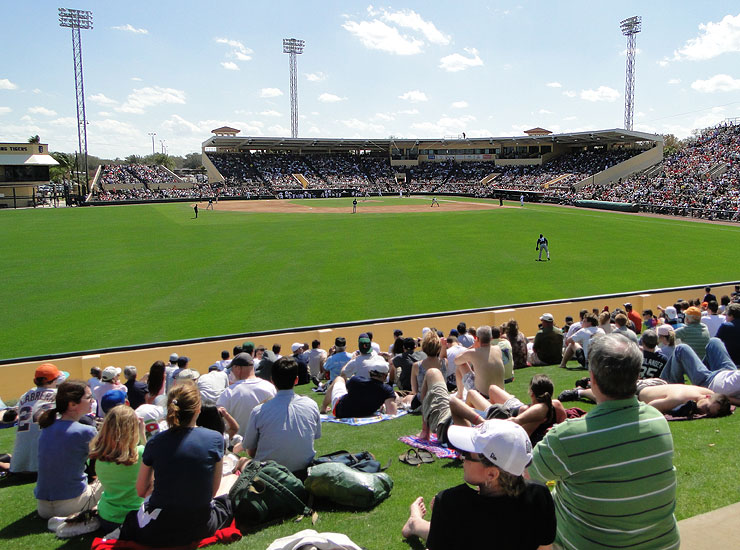
Joker Marchant Stadium Facts, Figures, Firsts & FootnotesOther stadium firsts (all of which occurred on 3/12/66):
For a complete and always up-to-date ballpark guide, visit the...
| |||||||||||||||||||||||||||||||||||||||||||||||||||||||||||||||||||||||||||||||||||||||||||||||||||||||||||||||||||||||||||||||||||||||||||||||||||||||||||||||||||||||||||||||
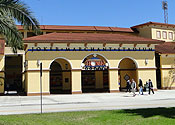



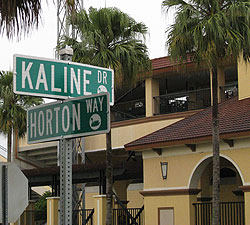 That fans traverse either Horton Way or Kaline Drive by car and then foot to arrive at one of the stadium's three gates not only speaks volumes about the Tiger legends, but also underscores the longevity between the team and its spring training ballpark. While other ballparks in Florida feature similar tributes, the sincerity is not quite the same in, for example, Fort Myers, where a Ted Williams statue fronts
That fans traverse either Horton Way or Kaline Drive by car and then foot to arrive at one of the stadium's three gates not only speaks volumes about the Tiger legends, but also underscores the longevity between the team and its spring training ballpark. While other ballparks in Florida feature similar tributes, the sincerity is not quite the same in, for example, Fort Myers, where a Ted Williams statue fronts 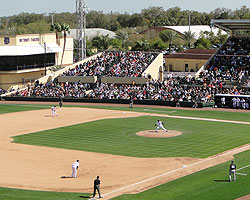 The closeness to the playing field is the reason cited for the placement of a protective screen in front of two of the newest field level sections, which seem no closer to the action than similar seats at similar stadiums. Nonetheless, the netting normally only found behind home plate extends two sections past the Tigers’ first base side dugout, although the two sections directly behind the Tigers’ dugout are sans the barrier netting, which is odd since that's a place where it is more commonly being found.
The closeness to the playing field is the reason cited for the placement of a protective screen in front of two of the newest field level sections, which seem no closer to the action than similar seats at similar stadiums. Nonetheless, the netting normally only found behind home plate extends two sections past the Tigers’ first base side dugout, although the two sections directly behind the Tigers’ dugout are sans the barrier netting, which is odd since that's a place where it is more commonly being found.
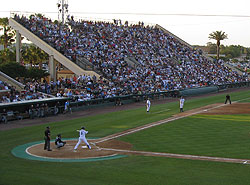 No signs are needed to find the enormous bleacher-filled grandstand that looms large down the left field line. Towering 35 rows high, the hulking concrete built structure made its debut in 1988, one year after the Tigers won their final AL East pennant. Today, the left field grandstand is the stadium’s sole architectural blight. Its seating chart splits the monstrosity into reserved and general admission sections. The first 11 rows of the grandstand’s ubiquitous silver bleacher benches have backs upon which seat numbers are plastered, hence their official designation as Left Field Reserved. But the bulk of the bleachers lack backs, seat or even row numbers and are filled on a first-come, first-served basis.
No signs are needed to find the enormous bleacher-filled grandstand that looms large down the left field line. Towering 35 rows high, the hulking concrete built structure made its debut in 1988, one year after the Tigers won their final AL East pennant. Today, the left field grandstand is the stadium’s sole architectural blight. Its seating chart splits the monstrosity into reserved and general admission sections. The first 11 rows of the grandstand’s ubiquitous silver bleacher benches have backs upon which seat numbers are plastered, hence their official designation as Left Field Reserved. But the bulk of the bleachers lack backs, seat or even row numbers and are filled on a first-come, first-served basis.
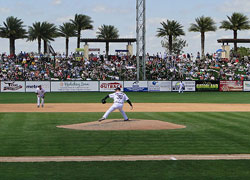
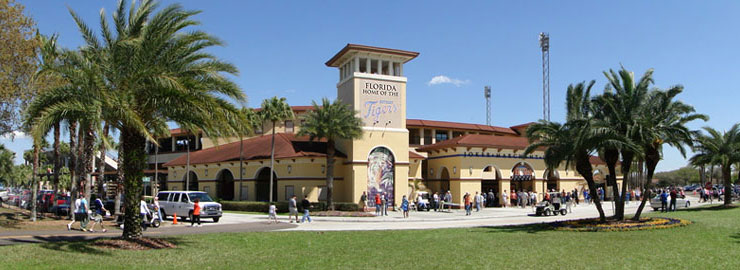
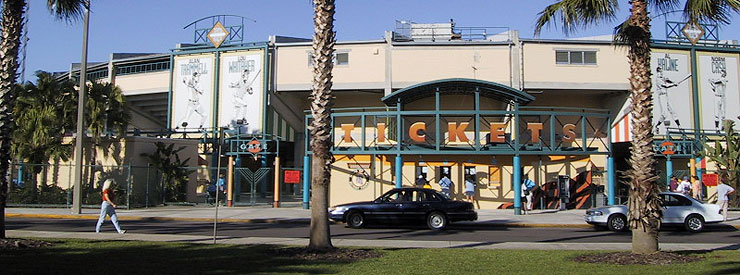
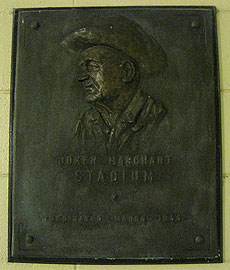 On March 12, 1966, Joker Marchant Stadium hosted its first game, a 4-2 victory for the Tigers over the Twins that was attended by 4,919 fans and the stadium’s namesake, Marcus Thigpen Marchant, who went by the name “Joker” and often wore a white cowboy hat. That explains why a weathered plaque in the stadium’s concourse that dates to 1966 is etched with a cowboy hat-wearing likeness of the city's longtime parks & rec director, who played a major role at keeping the Tigers in Tigertown while working for the city, which he did until retiring in 1978. Marchant died at his Lakeland home during spring training in 1983.
On March 12, 1966, Joker Marchant Stadium hosted its first game, a 4-2 victory for the Tigers over the Twins that was attended by 4,919 fans and the stadium’s namesake, Marcus Thigpen Marchant, who went by the name “Joker” and often wore a white cowboy hat. That explains why a weathered plaque in the stadium’s concourse that dates to 1966 is etched with a cowboy hat-wearing likeness of the city's longtime parks & rec director, who played a major role at keeping the Tigers in Tigertown while working for the city, which he did until retiring in 1978. Marchant died at his Lakeland home during spring training in 1983.
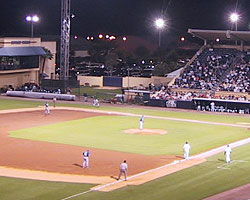 For those who pay to watch the game, enough new seating and standing room areas were added that Joker Marchant Stadium crowds can now swell to five figures, a milestone that was reached for the first time on March 27, 2010, when 10,219 paid to watch a Yankees-Tigers game. Such a lofty attendance was made possible by the addition of a berm in left field, hundreds of new box seats behind home plate and along the first base line, and six suites. Also, all seating in the grandstand was replaced, which meant the bright orange box seats below the cross aisle were removed, as were the less appealing aluminum bleachers with blue seat backs above the interior aisle. As a result, since 2003 all of the stadium’s grandstand has been filled with modern molded plastic stadium seats, each one painted dark green.
For those who pay to watch the game, enough new seating and standing room areas were added that Joker Marchant Stadium crowds can now swell to five figures, a milestone that was reached for the first time on March 27, 2010, when 10,219 paid to watch a Yankees-Tigers game. Such a lofty attendance was made possible by the addition of a berm in left field, hundreds of new box seats behind home plate and along the first base line, and six suites. Also, all seating in the grandstand was replaced, which meant the bright orange box seats below the cross aisle were removed, as were the less appealing aluminum bleachers with blue seat backs above the interior aisle. As a result, since 2003 all of the stadium’s grandstand has been filled with modern molded plastic stadium seats, each one painted dark green.
